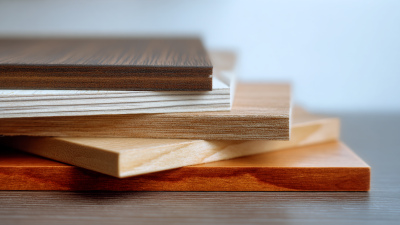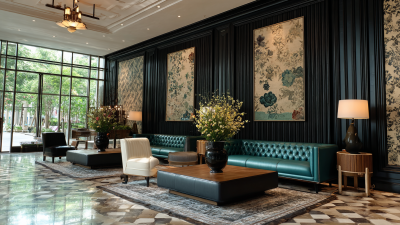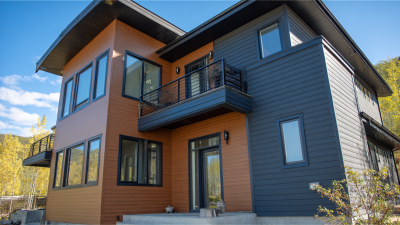How to Choose the Right WPC Wall Panel for Optimal Durability and Aesthetic Appeal
Table of Contents
- Factors Influencing the Durability of WPC Wall Panels: Material Composition and Treatment
- Aesthetic Considerations: Choosing the Right Color and Texture for Your WPC Panels
- Comparative Analysis: WPC Wall Panels vs. Traditional Wood and Vinyl in Performance
- Environmental Impact: The Sustainability of WPC Panel Production and Disposal
- Cost-Effectiveness: Evaluating the Long-Term Investment in WPC Wall Panels
- Maintenance Requirements: Tips for Preserving the Look and Longevity of WPC Wall Panels
- Transform Your Space: Benefits of WPC Wall Panels for Modern Interiors
- FAQS
- Conclusion
- Related Posts
When you're looking to boost both the durability and the visual appeal of your spaces, picking the right WPC Wall Panel really makes a difference. These panels are pretty awesome because they combine the best of both worlds — the natural look of wood mixed with the toughness of plastic. At Shandong WALLART New Building Material Co., Ltd., we’re all about creating top-quality WPC products for inside and outside use. We’re dedicated to making sure our customers get options that not only look great but also stand up to the test of time. In this blog, I’ll walk you through what to keep in mind when choosing the perfect WPC Wall Panel for your project — so you can make smart, confident choices that really upgrade your space without sacrificing performance or longevity.

Factors Influencing the Durability of WPC Wall Panels: Material Composition and Treatment
When you're picking out WPC (Wood Plastic Composite) wall panels, it's pretty important to get a handle on what affects how long they'll last. The makeup of the material really impacts how well the panels can handle stuff like weather, UV rays, and everyday knocks. Usually, good quality WPC panels mix wood fibers with thermoplastics, which makes them more resistant to moisture and rot compared to regular old wood. Just make sure to look for products that keep a good balance of both—this way, you get durability without sacrificing the looks you want.

Another key thing is how the panels are treated afterward. Things like co-extrusion or surface coating can give those panels some extra armor against the elements. For instance, panels that have UV stabilizers tend to keep their color and structure better over time—no fading or warping too soon.
A little tip: Always check the product details for info on where the materials come from and what kind of treatments they've been through. It's also smart to go for panels that come with a warranty; that usually shows the manufacturer really believes in how durable their product is. And, before you make a decision, it’s never a bad idea to read reviews or chat with pros—kind of like getting the inside scoop on how they actually perform in the real world.
Aesthetic Considerations: Choosing the Right Color and Texture for Your WPC Panels
When you're choosing WPC (Wood-Plastic Composite) wall panels, aesthetics really matter — especially if you want your space, whether inside or outside, to look just right. I came across a report by the Freedonia Group that says demand for WPC stuff in North America is actually expected to grow by about 6.7% each year up until 2023. Most of that boost comes from how much better they look compared to the old-school materials. Picking the right color is super important — it can totally change the vibe of a room. Right now, earthy tones like browns and deep greens are all the rage because they give off a cozy, welcoming feel.
Texture is another thing to keep in mind. According to MarketsandMarkets, textured panels don’t just look good — they’re more durable too. For example, panels with a wood grain finish not only look like real timber but also tend to last longer and are easier to take care of. If you’re going for a sleek, modern vibe, smooth finishes work best. But if you want a bit of rustic charm, embossed textures can do the trick. When you pick colors and textures that match your style, it’s easier to create a space that lasts and looks great. Trust me, a little thought goes a long way in making sure those panels really stand out — for all the right reasons.
Comparative Analysis: WPC Wall Panels vs. Traditional Wood and Vinyl in Performance
Thinking about using WPC wall panels for your next project? It’s definitely worth comparing them to the usual options like wood and vinyl. WPC panels are pretty impressive—they’re made from a mix of wood fibers and plastic composites—so they tend to be more durable and resistant to moisture than your typical wooden panels. That means they’re less likely to warp, crack, or rot over time, even in pretty harsh weather conditions.
Now, traditional wood can sometimes be a pain, right? It needs a lot of upkeep and can fall prey to rot or bugs if you're not careful. On the other hand, vinyl is super low-maintenance, but let’s be honest—it doesn’t really have that natural, warm look that many homeowners love. There are also eco-friendly options like natural fiber composites made from renewable stuff like jute or hemp, which are gaining popularity. But honestly, WPC panels hit that sweet spot—they bring together good looks and practicality.
At Shandong WALLART New Building Material Co., Ltd., we’re proud to craft high-quality WPC products for both indoor and outdoor use. They’re built to last and are designed with style in mind, making them a pretty awesome choice for modern buildings. So, if you want something durable, stylish, and a bit more fuss-free, WPC is definitely worth considering.
Environmental Impact: The Sustainability of WPC Panel Production and Disposal
When we talk about the environmental impact of WPC (that’s Wood-Plastic Composite) wall panels, it’s a pretty big deal these days, especially with everyone being more eco-conscious. Interestingly, a study from the U.S. Forest Service found that about half of the materials used to make WPC—like the wood and plastic—are recycled. That’s pretty cool because it means we’re relying less on new, virgin resources. Not only does this help reduce deforestation, but it also cuts down on plastic waste, giving these products a more sustainable life cycle. With more folks looking for green building materials, the WPC panel market is expected to grow over 16% each year—talk about a shift towards greener construction methods, right?
Oh, and here's another thing I find pretty interesting—disposal. WPC panels are actually more eco-friendly when it’s time to say goodbye. Unlike traditional materials that just pile up in landfills, WPC can often be recycled or reused after their initial use. A study from the University of Cambridge even suggested that by recycling WPC properly, we could cut landfill contributions by up to 30%. That’s a big plus! All in all, WPC not only supports sustainability but also aligns really well with those global efforts to push for a circular economy in construction. It’s like, we’re making smarter choices that benefit the planet in the long run.
Durability and Aesthetic Appeal of WPC Wall Panels
Cost-Effectiveness: Evaluating the Long-Term Investment in WPC Wall Panels
When you're thinking about WPC (Wood-Plastic Composite) wall panels, one of the biggest things to consider is how cost-effective they are in the long run. Sure, the initial price might be a bit higher than traditional materials, but honestly, they save you quite a bit over time. Because these panels resist rot, warping, and insect damage, you won’t need to replace them as often or spend a ton on maintenance. That durability really pays off, making WPC a smart choice financially if you’re looking at the big picture.
And let’s not forget how good they look! WPC panels come in all sorts of colors and finishes, so they can mimic natural wood pretty convincingly. Plus, they last longer, so you get that aesthetic appeal without sacrificing durability. Basically, installing WPC panels can really boost the look of your space, and in the long run, they’re a pretty wise investment that makes the upfront cost totally worth it.
Maintenance Requirements: Tips for Preserving the Look and Longevity of WPC Wall Panels
If you're trying to keep your WPC (Wood-Plastic Composite) wall panels looking good and lasting longer, regular maintenance is definitely the way to go. These panels are pretty tough and built to handle the weather, but if you don’t give them some TLC, they can start showing signs of wear or look dull over time. A good starting point is setting up a simple cleaning routine—just grab a mild detergent and a soft cloth. That’ll help get rid of dirt, grime, and stains without hurting the surface. Oh, and steer clear of strong chemicals; they might damage the panels or mess with their color.
Besides cleaning, it’s smart to protect your panels from moisture and sun damage too. Applying a UV-resistant sealant can help keep the colors vibrant and stop fading from sun exposure. Also, make sure you keep the surface free of leaves, twigs, and other debris—getting rid of that stuff regularly prevents water from sitting around and causing mold or other issues. And don’t forget to check in on the panels now and then. Look for any cracks, chips, or signs of damage and fix problems early on—that way, they’ll last longer and keep your space looking great. Pretty simple, right? Just a bit of regular care, and you’ll keep those panels looking fresh for years to come.
How to Choose the Right WPC Wall Panel for Optimal Durability and Aesthetic Appeal - Maintenance Requirements: Tips for Preserving the Look and Longevity of WPC Wall Panels
| Panel Type | Durability Rating | Aesthetic Options | Maintenance Frequency | Longevity (Years) |
|---|---|---|---|---|
| Textured Grain | High | Wood-like Finish | Every 6 months | 25 |
| Smooth Finish | Medium | Solid Colors | Every year | 20 |
| Recycled Composite | High | Natural Look | Every 6 months | 30 |
| Decorative Panels | Medium | Patterned | Every year | 15 |
| Fire-Retardant Panels | Very High | Custom Colors | Every 2 years | 35 |
Transform Your Space: Benefits of WPC Wall Panels for Modern Interiors
As modern interior design continues to evolve, the demand for innovative and versatile materials has surged, prominently featuring WPC (Wood Plastic Composite) wall panels. These panels, available in customized colors, bring not only aesthetic appeal but also a multitude of practical benefits that cater to contemporary spaces such as offices, hotels, shopping malls, and living rooms.
One of the standout features of WPC wall panels is their ease of installation, allowing designers and contractors to significantly reduce labor costs and installation time, typically completed in just a couple of days. According to industry reports, the construction materials market is expected to reach $1.4 trillion by 2025, with composite materials like WPC becoming increasingly favored due to their superior durability and low maintenance requirements. These panels measure 12mm by 204mm and can be customized to lengths of up to 2900mm, ensuring a perfect fit for various applications.
Beyond their functional attributes, WPC wall panels are environmentally friendly, as they emit no harmful pollutants, making them a great choice for health-conscious consumers. Fireproof, waterproof, and anti-scratch properties enhance their longevity, reducing the need for frequent replacements. With a typical delivery time of 15-20 days and a minimum order requirement of a full container, these panels are an excellent investment for those looking to transform their interiors with both style and substance.
FAQS
: WPC wall panels are made from a combination of wood fibers and thermoplastics, which enhances their durability and moisture resistance compared to traditional wood panels.
Treatment processes like co-extrusion and surface coating provide additional protection against environmental factors, helping panels to retain their color and structural integrity over time, especially those treated with UV stabilizers.
Consider the material sourcing, treatment methods, and check for product specifications. Panels with warranties often indicate the manufacturer's confidence in durability, and consulting professional reviews can help assess real-world performance.
WPC wall panels offer enhanced durability and resistance to moisture, making them less susceptible to warping, cracking, and decay compared to traditional wood panels, which require extensive maintenance and are prone to rot and insect damage.
WPC panel production utilizes about 50% recycled wood and plastic materials, reducing reliance on virgin resources, which helps decrease deforestation rates and minimizes plastic waste.
Yes, WPC wall panels can be repurposed or recycled after use, which makes their disposal more environmentally friendly compared to traditional materials that often end up in landfills.
WPC panels provide a balance of aesthetic versatility and practicality, offering natural visual appeal while being more resistant to common issues faced by traditional materials like wood and vinyl.
The WPC panel market is projected to grow by over 16% annually due to increasing demand for sustainable building materials, reflecting a shift towards greener construction methods.
WPC panels enhance sustainability through effective recycling strategies, potentially reducing landfill contributions by up to 30%, supporting global efforts towards circular economy practices in the construction industry.
Conclusion
When you're picking out the right WPC wall panel for your space, there are a few things you really want to keep in mind. Things like how durable it is and how good it looks matter a lot. The actual material and how it’s treated can make a big difference when it comes to standing up to weather and other environmental stresses. Plus, playing around with colors and textures can really make your space pop, whether it’s inside or outside. If you compare WPC panels to traditional wood or vinyl, you’ll find they often last longer and are easier to take care of, which is a big win.
Another thing to think about is the environment. WPC panels are actually pretty eco-friendly since they’re made in a way that’s better for the planet and easier to dispose of or recycle. So, not only are you making a smart choice for the planet, but it’s also a good long-term investment because they tend to require less maintenance and last longer. All in all, choosing WPC wall panels means you get stylish, practical, and sustainable options — a no-brainer for modern building projects or just sprucing up your home.
Related Posts
Blog Tags:

Olivia
-

Phone
-

E-mail
-

WhatsApp
Send Us A Message
Get Price And Free Samples Right Now!





